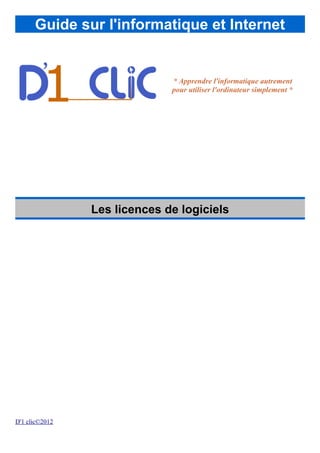
Les types de licence des logiciels
- 1. Guide sur l'informatique et Internet * Apprendre l'informatique autrement pour utiliser l'ordinateur simplement * Les licences de logiciels D'1 clic©2012
- 2. Un logiciel est au départ "écrit" à l'aide d'un langage informatique, compilé pour donner un fichier "exécutable" c'est-à-dire l'installateur du programme. Un fois installé dans votre ordinateur, il répartit de nombreux fichiers dans différents dossiers (windows, program files, mes documents...). Il est donc souhaitable de connaître la licence d'utilisation des logiciels que vous utilisez afin de savoir comment vous avez le droit de les utiliser et de les partager. Les différentes licences Le logiciel payant (propriétaire) Il est vendu par une société commerciale qui en a donc la propriété exclusive et détermine seule la façon de le vendre et de le distribuer. Le code source de ce logiciel n'est pas rendu public et reste donc la propriété exclusive de la société. De ce fait, son impact sur la sécurité de votre ordinateur est donc difficile à déterminer. Le logiciel en démonstration (shareware) C'est un logiciel propriétaire à la base mais qui est mis gratuitement à la disposition du public sous certaines conditions. Son utilisation peut être limitée dans le temps (généralement 1 mois) et/ou certaines de ses fonctions peuvent êtres désactivées. Pour l'utiliser pleinement, vous devez payer pour acquérir sa licence. Le logiciel gratuit (freeware) C'est aussi un logiciel propriétaire mis gratuitement à la disposition du public mais il n'est pas limité dans le temps. Toutefois, son utilisation est parfois soumise à conditions : ne pas l'utiliser dans un but commercial ou dans le cadre d'une entreprise par exemple. Le logiciel libre (open source) C'est un logiciel qui a été conçu et développé par une communauté (ouverte à tous) d'informaticiens et de sociétés diverses. Son code source est accessible, modifiable et distribuable par tous et de ce fait, il ne peut contenir du "code malveillant" qui pourrait nuire à la sécurité de l'ordinateur qui l'utilise. Un logiciel libre peut être néanmoins vendu mais à la condition que sa copie gratuite soit permise.
- 3. Exemple de logiciels libres • GNU/Linux (système d'exploitation) • Firefox (navigateur web) • Thunderbird (messagerie) • LibreOffice (suite bureautique) • Gimp (retouche d' image) • VLC (lecteur multimédia) • Scribus (mise en page) • Blender (création 3D) • InfraRecorder (gravage de CD/DVD) Pourquoi sont ils gratuits Les utilisateurs/programmeurs des premiers ordinateurs produits en série prirent l'habitude de former des groupes pour partager leurs expériences car il n'y avait alors pas de ressources pour se former, en dehors des formations dispensées par les fabricants. Ces groupes étaient soutenus par les fabricants eux-mêmes qui donnaient volontiers des infos techniques sur leurs logiciels. À cette époque, c'était le matériel informatique qui était censé constituer la source de revenus, le logiciel n'étant qu'un moyen d'en faciliter la vente. L'accès au code source était normal, car nul n'achetait un ordinateur sans disposer d'une équipe de programmeurs. Au début des années 70, les constructeurs sont contraints (par décision de justice) de facturer séparément leurs logiciels de leurs matériels ouvrant ainsi la porte à des sociétés qui ne vendent plus que des logiciels sous licence, la plus connue étant Microsoft qui commercialise Windows. Certains programmeurs (Richard Stallman et d'autres), en contestation à ce modèle économique, décident de créer une "licence libre" (GNU) pour pouvoir continuer à créer et utiliser des logiciels accessibles à tous. En résumé Logiciel Code source Utilisation Payant Fermé Totale Démonstration Fermé Limitée Gratuit Fermé Sous certaines conditions Libre Ouvert Totale
- 4. Table des matières Les différentes licences..................................................................................................................2 Le logiciel payant (propriétaire)................................................................................................2 Le logiciel en démonstration (shareware)..................................................................................2 Le logiciel gratuit (freeware).....................................................................................................2 Le logiciel libre (open source)...................................................................................................2 Exemple de logiciels libres....................................................................................................3 Pourquoi sont ils gratuits...................................................................................................3 En résumé......................................................................................................................................3